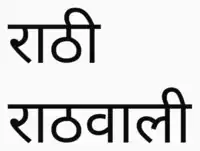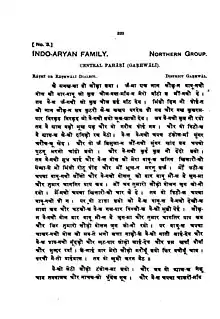| Rathwali | |
|---|---|
| राठवाली राठी | |
 | |
| Native to | India |
| Region | Uttarakhand |
| Language codes | |
| ISO 639-3 | – |
| Glottolog | rath1241 |
 Rathwali Approximate location of the Rathi-speaking area in India | |
| Coordinates: 30°03′55″N 78°30′23″E / 30.0653°N 78.5064°E | |
Rathwali(rāṭhavālī) or Rathi is spoken in the Pauri district of Uttarakhand state. Currently it has been classified as a dialect under Garhwhali,[1] belonging to the Central Pahari group(as per Grierson) which itself has been classified as a dialect of Hindi. It is also known as Rathi(rāṭhī). It comes under the Indo Aryan family.
Grammar
Gender :
Rules for gender are same as Srinagaria.
Number :
Tadbhava masc. nouns which end with a in Hindi, in Rathwali end with o. However some exceptions exist.
Cases :
| Case | |
|---|---|
| agent | न, ल |
| accusative | गणी |
| instrumental | न, ल |
| dative | गणी(to), खुणी(to) थां(to), कूं(for) |
| ablative | गणी(from), मकोई(from), बटी(from)
उण्डे(out of), मांय-ल(among), से , ते |
| genitive | को |
| locative | मा(in, into), माँ(in, into), गणी(in), पार(on), तल(below) |
Adjectives :
Follows same rules as Srinagaria, however the final a is changed into a.
Pronouns :
| sing. | pul. | |
|---|---|---|
| nom. | mi, mi
tu,tu |
ham, hamu
tum,tumu |
| ag, | mi-la, mai-la
ti-la, twe- la |
hamu-la, ham-na
tumu-la, tum-na |
| gen. | mero, myoro | tero, tyoro |
| obl. | mai, mi , mi
tai, ti, twa |
ham, hamu
tum, tumu |
| sing. | pul. | |
|---|---|---|
| nom. | yo
wo |
yo,yu
wo,wu |
| obl. | yai
wai, we,wi |
wo, wu
un, wun, u, wu |
| sing. | pul. | |
|---|---|---|
| nom. | jo, ju | jo |
| obl. | jai, je | jau |
| sing. | pul. | |
|---|---|---|
| nom. | so | so |
| obl. | tai, te | tau |
Reflexive Pronoun is aaphu
Conjugation :
Auxiliary Verbs & Verbs Substantive
| sing. | pul. | |
|---|---|---|
| I am | chhū, chhaū | chhawā |
| thou art | chhai,chhaī | chhavu |
| he is | chha, cha | chhī |
| sing. | pul. | |
|---|---|---|
| was | chhayō(masc)
chhayā(fem) |
chhōyō(masc)
chhāyā |
Comparative analysis
| Srinagaria | Rathwali | Translation |
|---|---|---|
| bal | latula | hair |
| baba te | babu gani | to a father/from a father |
| lokhar | luho | iron |
| nauno/nauni | laudo/laudi | boy/girl |
| hondo | honnu | being |
| janaani | siani | woman |
| ghar | kudo | house |
| khado ho | thado ho | stand up |
| door | tada | far |
| agadi/pichhadi | aghin/pachhin | after/before |
| Srinagaria | Rathwali | Translation |
|---|---|---|
| mai marda | mai mannu | I beat |
| tu mardi | tu marni | thou beatest |
| wo mard | wo marn | he beats |
| ham maarda | ham maarnu | we beat |
| tum marda | tum maarni | you beat |
| wo mardin | wo maani | they beat |
| main maare | mi la maara | I beat(past) |
| tin maare | ti la maara | thou beatest
(past) |
| wain maare | wa la maara | he beat(past) |
| haman maare | hamu la maara | we beat (past) |
| tuman maare | tumu la maara | you beat(past) |
| un maare | wunoon la maare | they beat(past) |
| mai maarnu chhaun | mi manu chhaun | I am beating |
| mai marnu chhayo | mi maarno chhoyo | I was beating |
| main maaryun chhayo | mai la maaryala | I had beaten |
| main maaroon | mi maaroon | I may beat |
| main maarulo | mi marulo | I shall beat |
| tu marilo | tu maril | thou wilt beat |
| wo marlo | wo marul | he will beat |
| ham maarla | ham maala | we shall beat |
| tum marilya | tum malya | you will beat |
| wo maarla | wo maala | they will beat |
Script & specimen

References
- 1 2 3 Grierson, George Abraham (1916). Linguistic Survey Of India Vol.9 Part.4. p. 315.
- ↑ Grierson, George Abraham (1916). Linguistic Survey Of India Vol.9 Part.4. pp. 312–313.
- ↑ Grierson, George Abraham (1916). Linguistic Survey Of India Vol.9 Part.4. pp. 313–314.
- ↑ Grierson, George Abraham (1916). Linguistic Survey Of India Vol.9 Part.4. p. 314.
- ↑ Grierson, George Abraham (1916). Linguistic Survey Of India Vol.9 Part.4. pp. 315–316.
- ↑ Grierson, George Abraham (1916). Linguistic Survey Of India Vol.9 Part.4. p. 316.